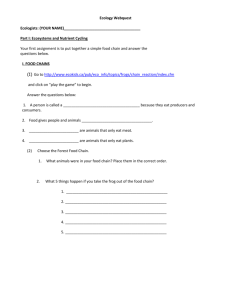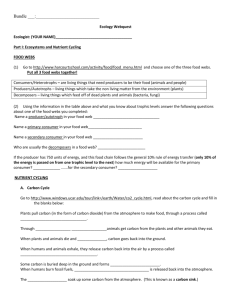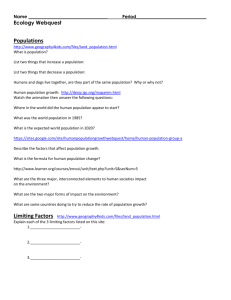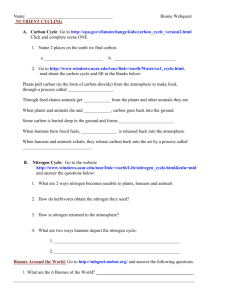Ecology Webquest - MsPittsBiologySpace
advertisement
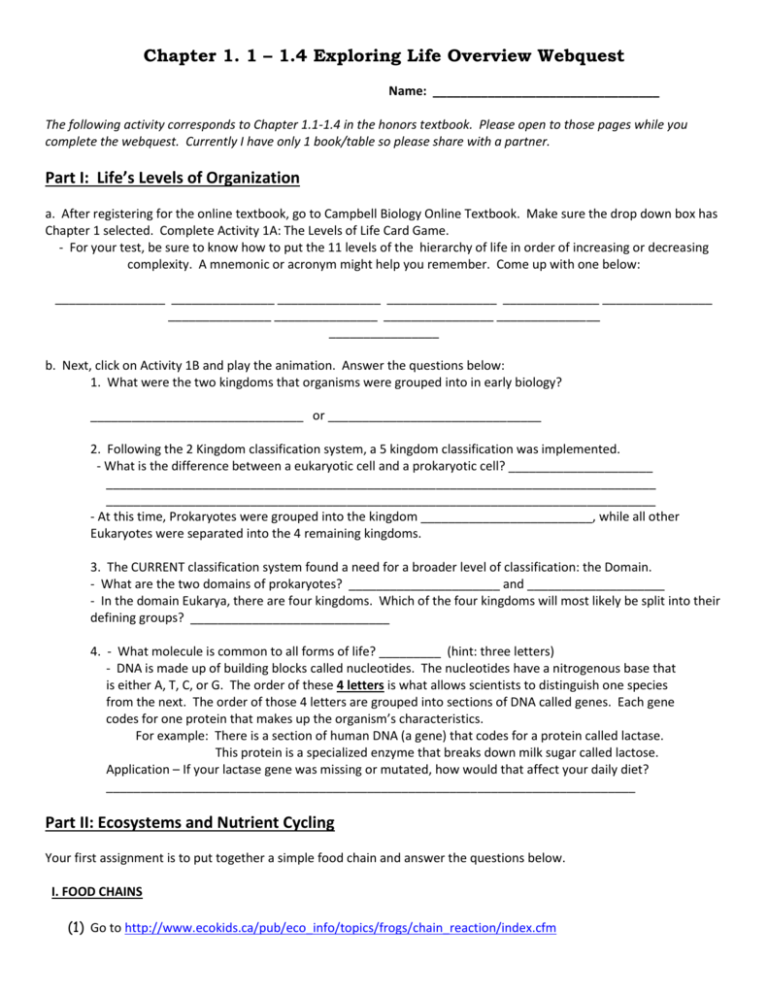
Chapter 1. 1 – 1.4 Exploring Life Overview Webquest Name: _________________________________ The following activity corresponds to Chapter 1.1-1.4 in the honors textbook. Please open to those pages while you complete the webquest. Currently I have only 1 book/table so please share with a partner. Part I: Life’s Levels of Organization a. After registering for the online textbook, go to Campbell Biology Online Textbook. Make sure the drop down box has Chapter 1 selected. Complete Activity 1A: The Levels of Life Card Game. - For your test, be sure to know how to put the 11 levels of the hierarchy of life in order of increasing or decreasing complexity. A mnemonic or acronym might help you remember. Come up with one below: ________________ _______________ _______________ ________________ ______________ ________________ _______________ _______________ ________________ _______________ ________________ b. Next, click on Activity 1B and play the animation. Answer the questions below: 1. What were the two kingdoms that organisms were grouped into in early biology? _______________________________ or _______________________________ 2. Following the 2 Kingdom classification system, a 5 kingdom classification was implemented. - What is the difference between a eukaryotic cell and a prokaryotic cell? _____________________ ________________________________________________________________________________ ________________________________________________________________________________ - At this time, Prokaryotes were grouped into the kingdom _________________________, while all other Eukaryotes were separated into the 4 remaining kingdoms. 3. The CURRENT classification system found a need for a broader level of classification: the Domain. - What are the two domains of prokaryotes? ______________________ and ____________________ - In the domain Eukarya, there are four kingdoms. Which of the four kingdoms will most likely be split into their defining groups? _____________________________ 4. - What molecule is common to all forms of life? _________ (hint: three letters) - DNA is made up of building blocks called nucleotides. The nucleotides have a nitrogenous base that is either A, T, C, or G. The order of these 4 letters is what allows scientists to distinguish one species from the next. The order of those 4 letters are grouped into sections of DNA called genes. Each gene codes for one protein that makes up the organism’s characteristics. For example: There is a section of human DNA (a gene) that codes for a protein called lactase. This protein is a specialized enzyme that breaks down milk sugar called lactose. Application – If your lactase gene was missing or mutated, how would that affect your daily diet? _____________________________________________________________________________ Part II: Ecosystems and Nutrient Cycling Your first assignment is to put together a simple food chain and answer the questions below. I. FOOD CHAINS (1) Go to http://www.ecokids.ca/pub/eco_info/topics/frogs/chain_reaction/index.cfm and click on “play the game” to begin. Answer the questions below: 1. A person is called a _____________________________________ because they eat producers and consumers. 2. Food gives people and animals __________________________________. 3. ________________________ are animals that only eat meat. 4. ________________________ are animals that only eat plants. (2) Choose the Forest Food Chain. 1. 2. What animals were in your food chain? Place them in the correct order. What 5 things happen if you take the frog out of the food chain? 1. _________________________________________________ 2. _________________________________________________ 3. _________________________________________________ 4. _________________________________________________ 5. _________________________________________________ II. FOOD WEBS (1) Go to http://www.harcourtschool.com/activity/food/food_menu.html and choose one of the three food webs. Put the food web together! Consumers – are living things that need producers to be their food (animals and people) Producers – living things which take the non living matter from the environment (plants) Decomposers – living things which feed off of dead plants and animals (bacteria, fungi) (2) Using the information in the table above and what you know about trophic levels answer the following questions about your food chain: Name a producer in your food web ________________________________ Name a primary consumer in your food web__________________________ Name a secondary consumer in your food web ________________________ Who are usually the decomposers in a food web? _______________________ If the producer has 100 units of energy, and this food chain follows the general rule of energy transfer (what percent is transferred on average?) how much energy will be available for the primary consumer? ________ How much energy will be available for the secondary consumer? __________ III. NUTRIENT CYCLING A. Carbon Cycle (1) (2) Go to http://www.kidsnewsroom.org/climatechange/carbon_cycle_version2.html Click and complete scene 1. Name 2 places on the earth we find carbon: 1. __________________________ (3) 2. ___________________________ Go to http://www.windows.ucar.edu/tour/link=/earth/Water/co2_cycle.html, read about the carbon cycle and fill in the blanks below: a. Plants pull carbon (in the form of carbon dioxide) from the atmosphere to make food, through a process called ____________________. b. Through food chains animals get ____________ from the plants and other animals they eat. c. When plants and animals die and ____________, carbon goes back into the ground. d. Some carbon is buried deep in the ground and forms ________________________.When humans burn fossil fuels, ________________ is released back into the atmosphere. e. When humans and animals exhale, they release carbon back into the air by a process called ______________________________. B. Nitrogen Cycle Go to the website http://www.windows.ucar.edu/tour/link=/earth/Life/nitrogen_cycle.html&edu=mid and answer the questions below: 1. What are 2 ways nitrogen becomes useable to plants, humans and animals: ________________________________ ________________________________ 2. How do herbivores obtain the nitrogen they need? __________________________________________________________________________________________ 3. How is nitrogen returned to the atmosphere? _________________________________________________________________________________________ 4. What are two ways humans impact the nitrogen cycle: 1.________________________________________ 2. _____________________________________________ B. Nitrogen cycle continued… Go to the following two websites http://www.tiscali.co.uk/reference/encyclopaedia/hutchinson/m0008077.html and http://www.vtaide.com/png/nitrogenCycle.htm and view the images of the Nitrogen Cycle as well as skim through the descriptions. 1. Compare/contrast the two images of the Nitrogen Cycle. What do they have in common? Is there anything unique about each image? ________________________________________________________________________________________ ________________________________________________________________________________________ ________________________________________________________________________________________ ________________________________________________________________________________________ 2. What absorbs the atmospheric nitrogen? ____________________ 3. What role do nitrogen-fixing bacteria play in the Nitrogen Cycle? _________________________ _______________________________________________________________________________ Play the Vermi Game to demonstrate the cycling of matter in a compost bin. Part IV: How Ecosystems are Developed Watch the youtube video (you will have to copy and paste the link into the address bar or the substitute will put it up the front screen.) http://www.youtube.com/watch?v=_Y9EQbKH_hA&feature=related (note if the video does not play, just move on to the next portion of the activity) Visit the web link Succession Link 1. How is primary succession different from secondary succession? _________________________ _____________________________________________________________________________ 2. Describe the example of secondary succession indicated in the simulation . ________________ _____________________________________________________________________________ 3. How does the rate of secondary succession compare to primary succession? _________________ 4. Imagine a lawn on campus or in someone's yard. Are there any examples of succession there now? If no one maintained it for five years, what might it look like? What would it look like after 10 years? 50? 100? _____________________________________________________________________________________
